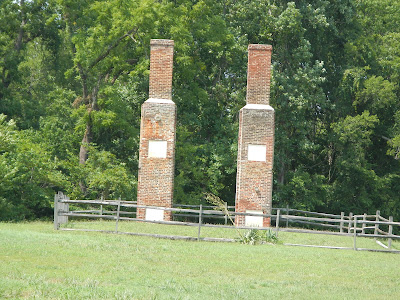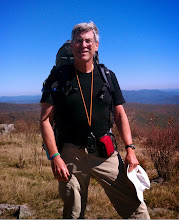It is still too hot to really enjoy a hike right now. It hit 104 yesterday and stayed there, and it is supposed to hit 103 today. Even in the mountains of Virginia, temperatures were in the 90's. So no hiking for me right now. But I did feel like writing a bit, and my post the other day about my new
DeLorme InReach satellite communicator made me reflect on why one might bother to carry such a thing with them.
Most of the time, hiking is not a dangerous activity. I would guess for most of us, the drive to and from the trail head carries more risk of death or serious injury than the hike itself. But like any activity, hiking does entail some risk. Things can and do happen. Hikers fall, drown (an AT through hiker drowned in Maine just the other day), get hypothermia, get lost, get bitten by poisonous snakes, and get attacked by wildlife. The hikes that I mostly do are less risky than, say, a two week solo trip through the Bob Marshall Wilderness, which is less risky than a month-long trip in the wilds of Alaska. But any hike involves some degree of risk. The risk increases if you are alone, as I sometimes am.
In the cases I have read about of hiking disasters, two solo hikers stick out in my mind: Mike Turner and John Donovan. One of them I knew personally, but I read articles about each of them in Backpacker Magazine. In both cases, had a device such as InReach been available - and if they carried one - they would likely still be hiking today.
In August 1998, the Reverend Mike Turner was a few days into a nine-day solo dream trip in Wyoming's Wind River Range with his dog, Andy. Just yards from a lake, a boulder he stepped on began to tip, and he instinctively jumped to the next large rock, which was sloped backwards. He slid rearward down its slope and off the edge, and at that exact instant, the huge boulder that he had leaped from completed its rotation and shut against the back of his legs just above his knees. He was essentially caught in a trap, feet off the ground, between the two boulders. He tried in vain to free himself multiple times, and kept a journal of his remaining days of suffering and longing for his family. His strong faith in God was shaken but, in the end, not broken. Just 30 feet from a lake, he slowly died of thirst and exposure over ten days.
A search had been implemented a couple of days after Reverend Turner failed to show up, but it was too late, and in any event, the searchers found no trace of him in the rugged wilderness. But five days after the search was called off in late August, Andy came out of the wild with some hikers who had found the exhausted but uninjured dog. That led to a new search being started, with the hope that Andy might be able to lead the search party back to his owner. On the same day that the new search began, a solo backpacker came across Mike Turner's body on this little-hiked route.
Mike Turner, whose full story you can read
here, really did nothing wrong. He caught a bad break. Had he by chance taken a slightly different route, he would have been fine. All of us have stepped on a rock that shifted, but in his case, it proved to be fatal.
I used to do some hikes with the Old Dominion Appalachian Trail Club (ODATC), and on a number of these, I met a man named John Donovan. I didn't know him well, but it was clear he was an avid hiker, leading a trip for the club just about every single weekend. I was shocked in late May of 2005 to learn from club news that John had gone missing on his dream hike of the Pacific Crest Trail to celebrate retirement. Because he was alone and had no family, people only realized he had gone missing when packages friends shipped him for points along his hike went unclaimed. A search was finally begun, and they learned that several people had actually seen John hiking and in some trouble in a May snowstorm on California's Mount Saint Jacinto. He had declined offers to hike into a town and get out of the storm, and was never seen alive again. As it turned out, lost, injured from a fall, and weakened, he stumbled down into a deep canyon and was unable to climb out. He celebrated his sixtieth birthday on May 11th by eating a couple of crackers. He wrote a note to a friend who was to have been hiking with him but wanted to delay three weeks because of snowy conditions. He told the friend that he regretted not following his advice, and said that he wanted to be buried in a US Navy cemetery. On May 14, 2005, John scribbled a final note that he was going down to Long Creek for water, ending with: "Goodbye and love to all."
Amazingly, John, who had helped many people in his life, helped save two lost hikers a year - nearly to the day - after his death. To read his full story, and how he managed to do this, you can go
here.
Unlike Mike Turner, John made mistake after mistake until his untimely death became certain barring a miracle rescue. I learned more about John from his close ODATC friends at a memorial meeting we had, and more still after reading the article in Backpacker Magazine referenced above. He took a lot of risks and was easily lost - not good traits for someone by themselves, under equipped and under dressed in a blinding snowstorm in the mountains. With a good tent, warm clothing, and a great sleeping bag, John could have hunkered down on the trail in the storm and survived. Or he could have chosen to go with the people who said to turn back, and made it out alive. Or he could have delayed his trip by three weeks and gone with his friend. It is a real tragedy that none of these things came to pass.
Had SPOT or InReach been available in 2005, and had John carried one - which I kind of doubt he would have - he still could have been rescued by sending an SOS message. So when I am hiking along, by myself or with others, in terrain and conditions a lot less harsh that either Mike Turner or John Donovan faced in their final days, memories of their sad tales is enough for me to justify the extra weight and cost of my DeLorme InReach, and my PN-60 GPS that is paired with it to send customized messages - along, of course, with a couple of pairs of spare Lithium batteries.


















































